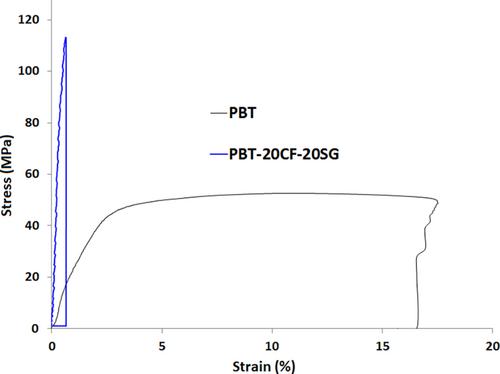Zafer Yenier, Yoldas Seki, Sibel Aker, Ferhat Öner, Lutfiye Altay, Mehmet Sarikanat
下载PDF
{"title":"The effect of hybrid thermal fillers on thermal conductivity of carbon fiber reinforced polybutylene terephthalate composites","authors":"Zafer Yenier, Yoldas Seki, Sibel Aker, Ferhat Öner, Lutfiye Altay, Mehmet Sarikanat","doi":"10.1002/pi.6622","DOIUrl":null,"url":null,"abstract":"<p>The use of functional polymeric composites with superior thermal properties, capable of replacing conventional polymers, has increased in recent years, particularly in the electrical-electronics sector where thermal management is crucial. Carbon fiber (CF) polymer–matrix structural composites have relatively high in-plane thermal conductivity but low through-plane conductivity. In order to further enhance the through-plane and in-plane conductivity of CF-reinforced polybutylene terephthalate (PBT) composite, a hybrid loading approach was employed, incorporating synthetic graphite (SG), boron nitride (hBN), aluminium nitride (AlN) and graphene (G) in composite formulations. It was found that the in-plane conductivity of PBT-20CF-20SG-3G and the through-plane conductivity of PBT-20CF-20SG-3AlN are 69% and 25% higher, respectively, than those of PBT-40CF. However, the mechanical properties of hybrid composites exhibit lower values compared to those of CF-reinforced PBT composites. The tensile strength value of PBT-40CF is about 33% and 57% higher than those of PBT-20CF-20SG-3G and PBT-20CF-20SG-3AlN. Moreover, the flexural strength of PBT-40CF is about 48% and 38% higher than those of PBT-20CF-20SG-3G and PBT-20CF-20SG-3AlN, respectively. The density value of PBT-40CF is lower than that of the composites of PBT-20CF-20SG. From TGA it was observed that the thermal stability of PBT-40CF is comparable to that of the composites PBT-20CF-20SG. From the conducted study, it can be proposed that the hybrid combination of SG, hBN, AlN and G can be utilized to achieve higher thermal conductivity values, instead of relying solely on CF in the composites. © 2024 The Authors. <i>Polymer International</i> published by John Wiley & Sons Ltd on behalf of Society of Industrial Chemistry.</p>","PeriodicalId":20404,"journal":{"name":"Polymer International","volume":"73 6","pages":"484-493"},"PeriodicalIF":2.9000,"publicationDate":"2024-02-20","publicationTypes":"Journal Article","fieldsOfStudy":null,"isOpenAccess":false,"openAccessPdf":"https://onlinelibrary.wiley.com/doi/epdf/10.1002/pi.6622","citationCount":"0","resultStr":null,"platform":"Semanticscholar","paperid":null,"PeriodicalName":"Polymer International","FirstCategoryId":"92","ListUrlMain":"https://onlinelibrary.wiley.com/doi/10.1002/pi.6622","RegionNum":4,"RegionCategory":"化学","ArticlePicture":[],"TitleCN":null,"AbstractTextCN":null,"PMCID":null,"EPubDate":"","PubModel":"","JCR":"Q2","JCRName":"POLYMER SCIENCE","Score":null,"Total":0}
引用次数: 0
引用
批量引用
Abstract
The use of functional polymeric composites with superior thermal properties, capable of replacing conventional polymers, has increased in recent years, particularly in the electrical-electronics sector where thermal management is crucial. Carbon fiber (CF) polymer–matrix structural composites have relatively high in-plane thermal conductivity but low through-plane conductivity. In order to further enhance the through-plane and in-plane conductivity of CF-reinforced polybutylene terephthalate (PBT) composite, a hybrid loading approach was employed, incorporating synthetic graphite (SG), boron nitride (hBN), aluminium nitride (AlN) and graphene (G) in composite formulations. It was found that the in-plane conductivity of PBT-20CF-20SG-3G and the through-plane conductivity of PBT-20CF-20SG-3AlN are 69% and 25% higher, respectively, than those of PBT-40CF. However, the mechanical properties of hybrid composites exhibit lower values compared to those of CF-reinforced PBT composites. The tensile strength value of PBT-40CF is about 33% and 57% higher than those of PBT-20CF-20SG-3G and PBT-20CF-20SG-3AlN. Moreover, the flexural strength of PBT-40CF is about 48% and 38% higher than those of PBT-20CF-20SG-3G and PBT-20CF-20SG-3AlN, respectively. The density value of PBT-40CF is lower than that of the composites of PBT-20CF-20SG. From TGA it was observed that the thermal stability of PBT-40CF is comparable to that of the composites PBT-20CF-20SG. From the conducted study, it can be proposed that the hybrid combination of SG, hBN, AlN and G can be utilized to achieve higher thermal conductivity values, instead of relying solely on CF in the composites. © 2024 The Authors. Polymer International published by John Wiley & Sons Ltd on behalf of Society of Industrial Chemistry.
混合热填料对碳纤维增强聚对苯二甲酸丁二醇酯复合材料导热性的影响
近年来,具有优异热性能的功能性聚合物复合材料的使用日益增多,尤其是在对热管理至关重要的电气电子领域。碳纤维聚合物基体结构复合材料具有相对较高的面内热导率,但面间热导率较低。为了进一步提高碳纤维(CF)增强聚对苯二甲酸丁二醇酯(PBT)复合材料的面内和面外传导性,研究人员采用了混合负载法,在复合材料配方中加入了合成石墨(SG)、氮化硼(HBN)、氮化铝(AlN)和石墨烯(G)。结果表明,PBT-20CF-20SG-3G 的面内电导率和 PBT-20CF-20SG-3AlN 的面间电导率分别比 PBT-40CF 高 69% 和 25%。然而,与 CF 增强 PBT 复合材料相比,混合复合材料的机械性能值较低。PBT-40CF 的拉伸强度值比 PBT-20CF-20SG-3G 和 PBT-20CF-20SG-3AlN 分别高出约 33% 和 57%。此外,PBT-40CF 的抗弯强度比 PBT-20CF-20SG-3G 和 PBT-20CF-20SG-3AlN 分别高出约 48% 和 38%。PBT-40CF 的密度值低于 PBT-20CF-20SG 的复合材料。热重分析(TGA)显示,PBT-40CF 的热稳定性与 PBT-20CF-20SG 复合材料相当。根据所进行的研究,可以建议利用 SG、HBN、AlN 和 G 的混合组合来获得更高的热导率值,而不是仅仅依赖复合材料中的 CF。
本文章由计算机程序翻译,如有差异,请以英文原文为准。


 求助内容:
求助内容: 应助结果提醒方式:
应助结果提醒方式:


